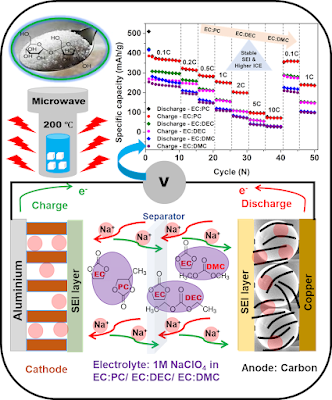Optimizing ultramicroporous hard carbon spheres in carbonate ester-based electrolytes for enhanced sodium storage in half-/full-cell sodium-ion batteries
Wiley Battery Energy; Publication Date: June 22, 2022
DOI: https://doi.org/10.1002/bte2.20220007
Author(s): Nagmani (IIT Kharagpur); Sreeraj Puravankara (IIT Kharagpur)
Sodium-ion batteries (SIBs) have received considerable attention as promising next-generation energy storage systems due to a large abundance of sodium and ion storage chemistry similar to that of lithium-ion batteries (LIBs). We report ultramicroporous hard carbon microspheres (HCMSs) derived from sucrose via a microwave-assisted solvothermal reaction as anode for SIBs. Because of the HCMSs with a larger interlayer spacing in graphitic domains and ultramicropores, it delivers excellent 3-RC features (reversible capacity, rate capability, and retention of capacity) reported to date for hard carbons derived from sugar-based carbon precursors through electrolyte optimization of carbonate esters (EC:PC, EC:DEC, EC:DMC). The HCMS-PC delivered the best reversible capacity of 265 mAh g−1 at a current density of 300 mA g−1, showing 85.8% capacity retention after 100 cycles and 66.3% capacity retention after 500 cycles in a half-cell. A full-cell fabricated with an HCMS-PC anode and a Na3V2(PO4)3 cathode delivered reversible capacities of 81 and 48 mAh g−1 at current densities of 30 and 300 mA g−1, respectively.

Comments
Post a Comment